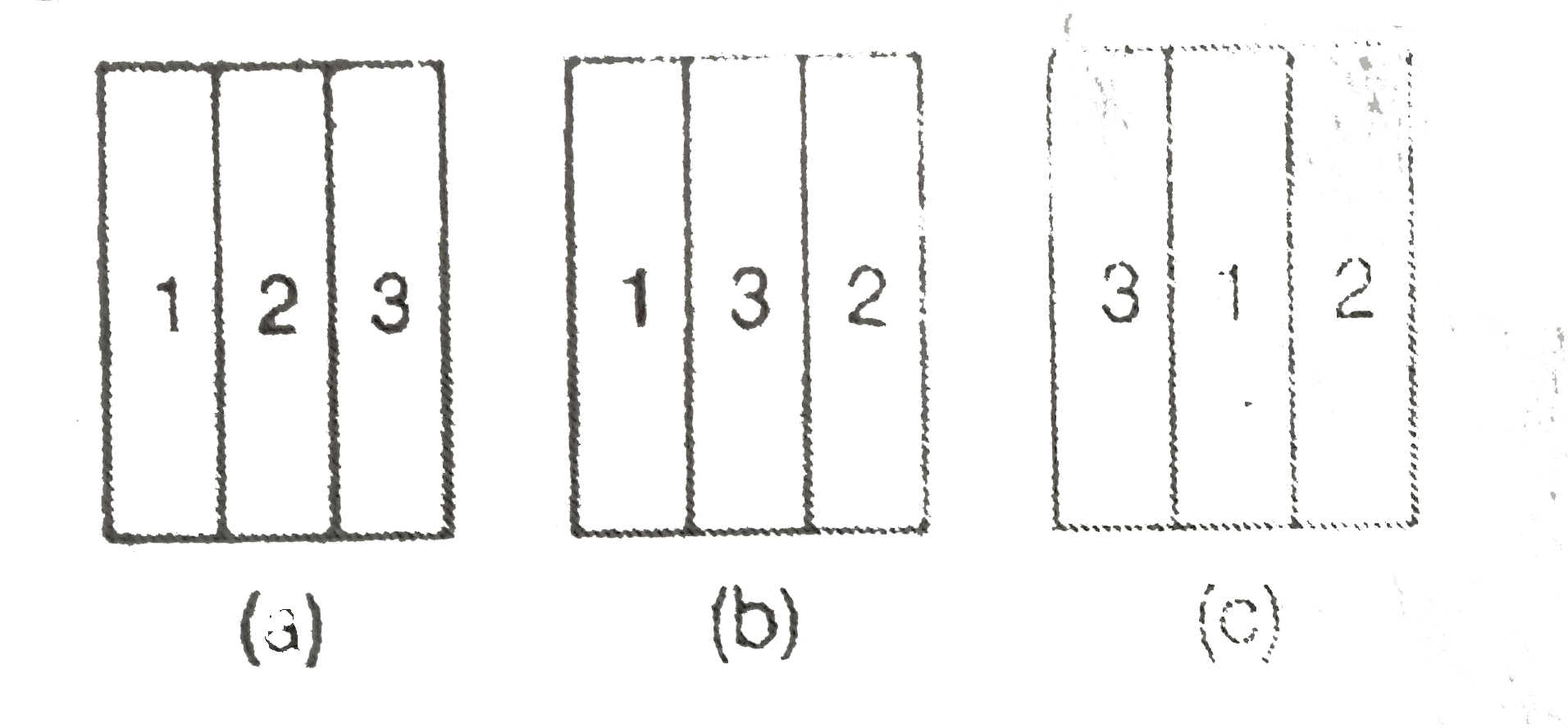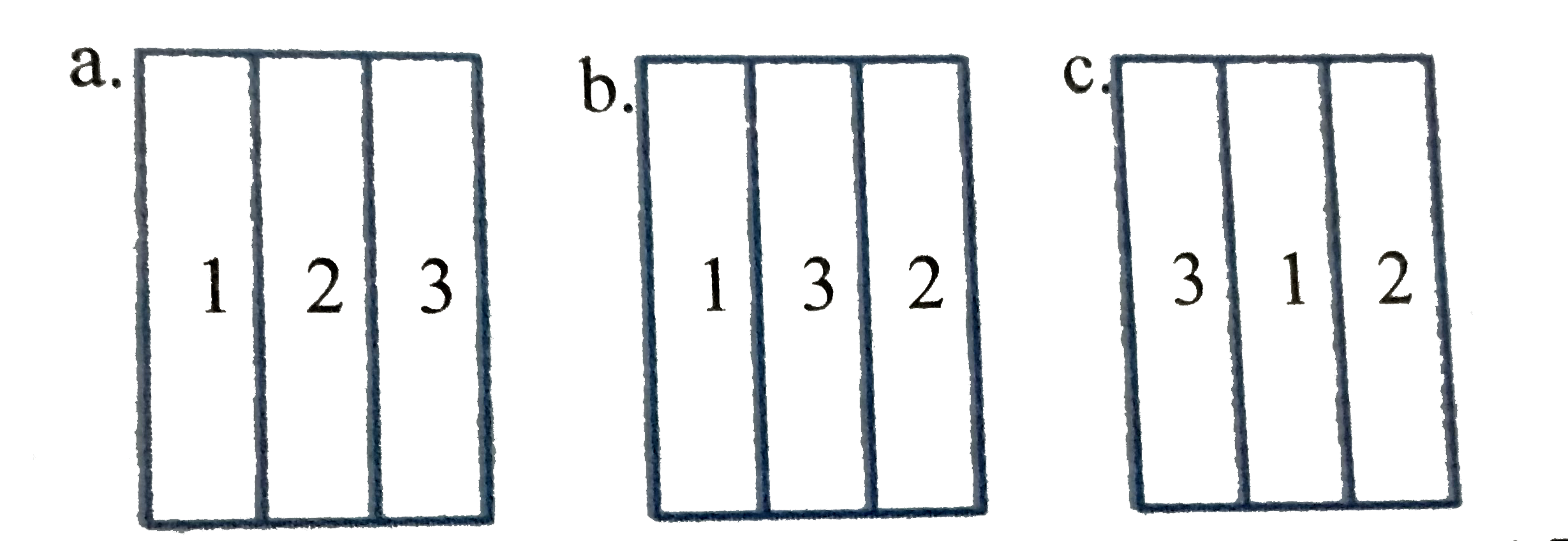Figure, shown three different arrangements of materials 1, 2 and 3 to from a wall. Thermal conductivities are k1>k2>k3. The left side of the wall is 20∘C higher than the right side. The temperature difference ΔT across the material 1 has following relation in three cases

In steady state, the rate of energy conduction through the wall III is greatest
In steady state, the rate of energy conduction though all the walls (I),(II) and (III) are same
In steady state, temperature difference across material l is greatest in wall II.
In steady state, temperature differnce across material l is same in all the walls
The correct Answer is:B, D
Step by step video & image solution for Figure, shown three different arrangements of materials 1, 2 and 3 to from a wall. Thermal conductivities are k_(1)gtk_(2)gtk_(3). The left side of the wall is 20^(@)C higher than the right side. The temperature difference DeltaT across the material 1 has following relation in three cases by Physics experts to help you in doubts & scoring excellent marks in Class 11 exams.
Updated on:21/07/2023Topper's Solved these Questions
- TRANSMISSION OF HEATBOOK - CENGAGE PHYSICS ENGLISHCHAPTER - TRANSMISSION OF HEATEXERCISE - Comprehension type
4 Videos
- TRANSMISSION OF HEATBOOK - CENGAGE PHYSICS ENGLISHCHAPTER - TRANSMISSION OF HEATEXERCISE - Fill in the blanks type
6 Videos
- TRANSMISSION OF HEATBOOK - CENGAGE PHYSICS ENGLISHCHAPTER - TRANSMISSION OF HEATEXERCISE - Single correct
9 Videos
- THERMODYNAMICSBOOK - CENGAGE PHYSICS ENGLISHCHAPTER - THERMODYNAMICSEXERCISE - 24
1 Videos
- TRAVELLING WAVESBOOK - CENGAGE PHYSICS ENGLISHCHAPTER - TRAVELLING WAVESEXERCISE - Integer
9 Videos
Similar Questions
Three different arrangemnets of matrials 1 and 2,3 to from a wall Thremal conductivities are k1>k2>k3 The left side of the wall is 20∘C higher than the right side Temperature difference ΔT across the material 1 has following relation in three cases

View SolutionTwo identical rods are made of different materials whose thermal conductivities are K1andK2. They are placed end to end between two heat reservoirs at temperatures θ1andθ2. The temperature of the junction of the rod is

View Solution
Knowledge Check
A wall has two layers A and B, each made of different materials. Both the layers have the same thickness. The thermal conductivity of the material of A is twice that of B. Under thermal equilibrium , the temperature differeence across the wall is 36∘C. The temperature difference across the layer A is
A6∘CB12∘CC18∘CD24∘CA wall has two layers A and B, each made of different material. Both the layers have the same thickness. The thermal conductivity of the material of A is twice that of B . Under thermal equilibrium, the temperature difference across the wall is 36∘C. The temperature difference across the layer A is
A12.∘CB18.∘CC6.∘CD24.∘C
A wall has two layers A and B made of two different materials thermal conductivities KA and KB (KA=3KB). The thickness of both the layers is same. The temperature across the wall is 20∘C in thermal equilibrium. Then
View SolutionTwo rods A and B of different materials are welded together as shown in figure. Their thermal conductivities are K1 and K2. The thermal conductivity of the composite rod will be

View SolutionA slab consists of two layers of different materials of the same thickness and having thermal conductivities K1 and K2. The equivalent thermal conductivity of the slab is
View SolutionTwo slabs A and B of different materials but of the same thicknesss are joined end to end to form a composite slab. The thermal conductivities of A and B are K1 and K2 respectively. A steady temperature difference of 12∘C is maintained across the composite slab. If K1=K22, the temperature difference across slabs A is
View SolutionA partition wall has two layers of different materials A and B in contact with each other. They have the same thickness but the thermal conductivity of layer A is twice that of layer B. At steady state the temperature difference across the layer B is 50 K, then the corresponding difference across the layer A is
View SolutionA wall has two layers A and B, each made of different material. Both the layers have the same thickness. The thermal conductivity of the material of A is twice that of B . Under thermal equilibrium, the temperature difference across the wall is 36∘C. The temperature difference across the layer A is
View Solution
